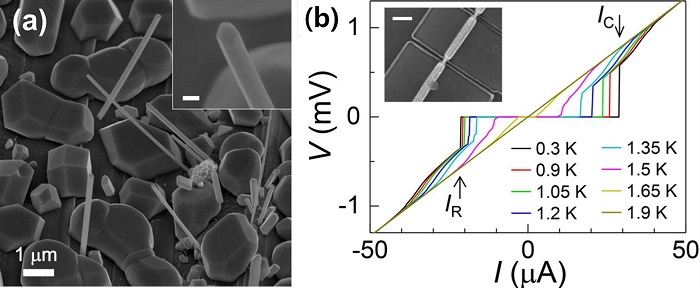2017.11.29
Professor Yong-Joo Doh of the Department of Physics and Photon Science at the Gwangju Institute of Science and Technology (GIST, President Seung Hyeon Moon) and KAIST Professor Bongsoo Kim have successfully observed a macroscopic quantum penetration phenomenon using a superconducting transistor.
This research will contribute to the study of new quantum information devices using phase-super-current and will contribute to a topologically stable quantum state by using phase-insulated nanowires.
Phase-insulated nanowires are One-dimensional nanostructures made of phase-insulating materials. Phase insulation material has a similar energy gap to a general insulator and has a metallic-like electrical conductivity on the surface of the insulator in accordance with topological conditions.
Super-current transistor is a transistor device that applies the principle of quantum physics to turn on or off the super-current by applying a voltage to the gate electrode.
(Secondary current has no current loss due to the current flowing in the material state where the resistance becomes zero by the quantum physics principle.)
Theoretical physicists predict that a quantum computer capable of conserving quantum states in a topologically safe manner can be implemented if a super-current device using a phase insulator is used.
In order to experimentally verify these predictions, it is necessary to go through several stages of testing. The presence of quantum wells, which can conceal the quantum state, should first be proved. Observations of macroscopic quantum penetration phenomena can be evidence that a quantum well exists within a super-current device because a super-current device can be thought of as a one-dimensional system attached to a quantum well.
In the case of conventional superconducting quantum devices, the superconducting current through the metal oxide bonding is used, whereas the superconducting device using the phase insulating nanowire can control the individual superconducting devices by using the gate voltage. It has advantages.
Macroscopic Quantum Penetration:
Small particles of atomic size trapped in a quantum well can be present beyond the energy barrier by a quantum penetration phenomenon. In the case of superfluids or superconductors, the macroscopic size of more than a few micrometers (a unit of length corresponding to one millionth of a meter) may cause quantum transmission, which is called macroscopic quantum transmission.
Professor Yong-Joo Doh and Professor Bongsoo Kim use a superconducting aluminum electrode on silver-selenium (Ag2Se) phase-insulated nanowire to fabricate a super-current transistor. The statistical measurement of the superconducting-steady-state current distribution in the vicinity of the critical current of the superconducting current in the device has experimentally observed that a macroscopic quantum penetration of superconducting current occurs at an absolute temperature of less than 0.8 Kelvin.
This temperature is the highest threshold observed for macroscopic quantum penetration so far when compared to previous results observed in the graphene current device (published in Nature Communications in 2013) or in the lead sulfide super-current device (published in ACS Nano in 2017).
Absolute temperature: The temperature system expressed in Kelvin. Absolute zero (0 Kelvin) corresponds to minus 273.15 Celsius, and quantum computers using super currents operate reliably at a cryogenic temperature of about 0.01 Kelvin.
Professor Dooyong Yoo said, "The results of this study indicate that we are one step closer to the ultimate goal of quantum computers using phase super-current devices. If we make a little more technological progress, we can experimentally observe the energy quantization from the supercurrent quantum well and artificially control it by using the gate voltage."
This work was supported by the NRF of Korea through the Basic Science Research Program and the SRC Center for Quantum Coherence in Condensed Matter, and their paper "Macroscopic Quantum Tunneling in Superconducting Junctions of β-Ag2Se Topological Insulator Nanowire" published on October 24, 2017, in Nano Letters.













